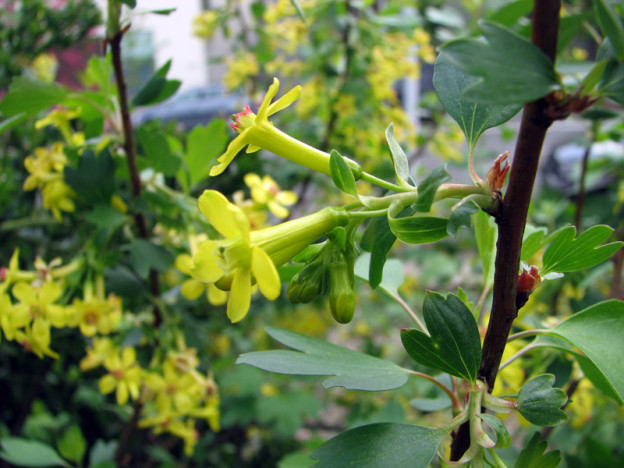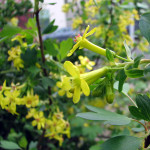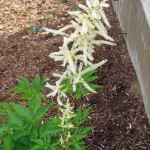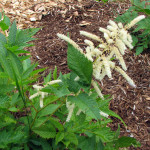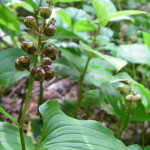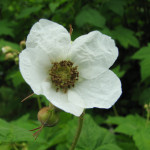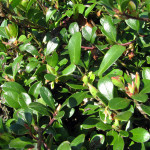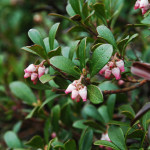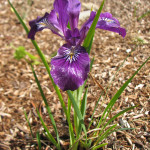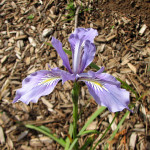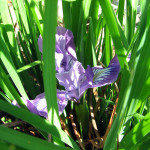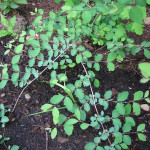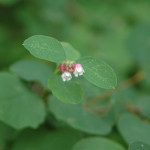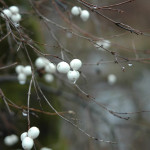Ribes aureum
Golden currant (Ribes aureum) is a small to medium-sized deciduous shrub named for its golden flowers and golden red fall foliage. It is common in Oregon and Washington east of the Cascades and into the Great Basin.
Golden currant grows in full sun and partial shade, in dry to moist conditions, and is drought tolerant. The leaves are deciduous, lobed, and vaguely maple-like, ½ – 1½ inches. Charming clusters of yellow flowers bloom from mid- to late-spring. Golden currant grows to approximately 6 feet tall by 6 feet wide.
It attracts hummingbirds and butterflies such as the spring azure and mourning cloak, and the fruit is eaten by birds and other wildlife. Combine this in a sunny spot with its cousin, red-flowering currant, and drought-tolerant groundcovers like alliums and camas, for a beautiful native display!
- Light Requirements: Full Sun, Part Shade
- Water Requirements: Dry, Moist
- Ease of Growing:
- Growth Rate: Moderate
- Spreads: No
- Wildlife Support: Hummingbirds, Birds or Mammals
- Fire-resistant: No
- Edible: Yes
- Mature Height: 6ft
- Mature Width:6ft
Goat’s Beard

Aruncus dioicus
Goat’s Beard has decorative finely-cut foliage and will create a bold, showy effect for a moist or partly-shaded spot all season. Dense, feathery plumes of tight white flowers rise well above the foliage spring to summer.
Goat’s Beard is an excellent background plant or grouped in a woodland setting. It dies back to the ground in winter, only to return gloriously in the spring. Goat’s Beard spreads slowly by rhizomes to form attractive patches, and can be planted in more sunny areas provided there is good moisture. It’s a “host” plant to the Dusky Azure Butterfly.
- Light Requirements: Part Shade, Full Shade
- Water Requirements: Moist, Perennially Wet
- Ease of Growing: Easy to grow
- Growth Rate: Fast
- Spreads: Yes
- Wildlife Support: Pest-eating Insects, Birds or Mammals, Pollinators
- Fire-resistant: No
- Edible: No
- Mature Height: 5-15ft
- Mature Width:3-5ft
False lily-of-the-valley
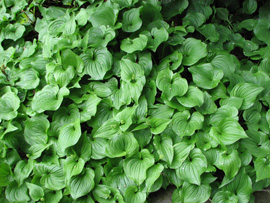
Maianthemum dilatatum
The plant produces an erect, unbranched stem up to about 40 centimeters tall. A non-flowering shoot bears one smooth, waxy, shiny leaf up to 10 centimeters long and 5 to 8 broad, hence its scientific name (dilatatum means ‘broad’). On plants that are flowering, 2 or 3 leaves are produced oppositely on the stems. The leaf is oval in shape with a heart-shaped base. This attractive groundcover can spread vigorously when in planted in favorable conditions.
The inflorescence is an erect raceme with star-shaped white flowers. They each have four petals and four stamens. After fertilization the fruit produced is a berry 6 millimeters in diameter. The berry is speckled red when immature and solid red when ripe. Each has 1 to 4 seeds.
- Light Requirements: Part Shade, Full Shade
- Water Requirements: Moist
- Ease of Growing: Easy to grow
- Growth Rate: Moderate
- Spreads: Yes
- Wildlife Support: Birds or Mammals
- Fire-resistant: Yes
- Edible:
- Mature Height: 1ft
- Mature Width:2-3ft
Thimbleberry

Rubus parviflorus
Thimbleberry (Rubus parviflorusis) is a dense, spreading deciduous shrub that grows 4-6 feet tall and wide. It is a friendly plant with large, soft, fuzzy leaves and no thorns or prickles. The white flowers have five petals and a pale yellow center. The delicious fruits are like large, soft, velvety raspberries.
Thimbleberries are used by many kinds of wildlife year round. They are important sources of nectar, nest material, and winter shelter for native bees. Yellow-banded sphinx moths eat the leaves when young, and the berries are eaten by dozens of species.
These thicket-forming plants typically grow along roadsides, railroad tracks, and in forest clearings, commonly appearing soon after clear cuts and forest fire areas. In urban areas, thimbleberries can form a natural hedge at the back of the garden or provide cover on sunny, dry hillsides.
- Light Requirements: Full Sun, Part Shade, Full Shade
- Water Requirements: Dry, Moist
- Ease of Growing: Easy to grow
- Growth Rate: Moderate
- Spreads: Yes
- Wildlife Support: Pollinators, Hummingbirds, Pest-eating Insects, Birds or Mammals
- Fire-resistant: No
- Edible: Yes
- Mature Height: 4-6ft
- Mature Width:3-6ft
Kinnikinnick
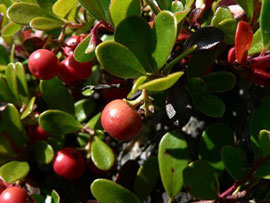
Arctostaphylos uva-ursi
Kinnikinnick is a species of Arctostaphylos, one of several related species referred to as bearberry or kinnikinnick. The distribution is circumpolar, widespread in northern latitudes, confined to high altitudes further south. In North America, it ranges from arctic Alaska, Canada and Greenland south to California.
It is a small, spreading procumbent woody shrub 5-30 cm high. The leaves are evergreen, remaining green for 1-3 years before falling. The fruit is a red berry. The leaves are shiny, small, and feel thick and stiff. In spring, kinnikinnick produces white or pink flowers. They are a common plant on Jack pine sites. They grow well in dry, sunny gardens.
Uses
Kinnikinnick has historically been used for medicinal purposes. It contains the glycoside arbutin, which has antimicrobial properties and acts as a mild diuretic. It has been used for urinary tract complaints, including cystitis and urolithiasis.
- Light Requirements: Full Sun
- Water Requirements: Dry, Moist
- Ease of Growing: Easy to grow
- Growth Rate: Fast
- Spreads: Yes
- Wildlife Support: Pollinators, Hummingbirds, Pest-eating Insects, Birds or Mammals
- Fire-resistant: Yes
- Edible: No
- Mature Height: 5-8in.
- Mature Width:2-15ft
Tall Oregon Grape

Mahonia aquifolium (Berberis aquifolium)
Tall Oregon grape (Mahonia aquifolium) is the state flower of Oregon. The plant is not related to grapes, but gets the name from the purple clusters of berries it produces every fall. Its sharply pointed leaves resemble holly. The bright yellow clusters of flowers in April and May are both a lovely sign of spring, and a welcome sources of nectar for early pollinators including mason bees and bumblebees.
Painted lady butterflies, half-white carpet moths, mining bees, and other insects also use the flowers for food. The berries are eaten by many wildlife, including robins, waxwings, juncos, sparrows, and towhees, as well as foxes, coyotes, and raccoons.
Tall Oregon grape is well suited for low-maintenance plantings or loose evergreen hedges. It grows 5-8 feet tall depending on conditions, so in the garden it serves as a good evergreen backdrop, especially when combined with salal, sword fern, and evergreen hucklebery. Tall Oregon grape tolerates poor soils and summer drought, especially if it has some shade.
- Light Requirements: Full Sun, Part Shade
- Water Requirements: Dry, Moist
- Ease of Growing: Easy to grow
- Growth Rate: Moderate
- Spreads: Yes
- Wildlife Support: Pollinators, Hummingbirds, Pest-eating Insects, Birds or Mammals
- Fire-resistant: Yes
- Edible: Yes
- Mature Height: 5-8ft
- Mature Width:2-8ft
Oregon iris

Iris tenax
Iris tenax is a species of Iris native to southwestern Washington and northwestern Oregon. It is known as the tough-leaved iris or Oregon iris. It occurs along roadsides and in grasslands and forest openings at low to middle elevations. One subspecies is also known from northern California.
Like most irises, it has large and showy flowers. The flowers bloom in mid to late spring and are usually lavender-blue to purple, but blooms in white, yellow, pink, and orchid shades are known to sometimes occur.
- Light Requirements: Full Sun, Part Shade
- Water Requirements: Dry, Moist
- Ease of Growing: Moderate
- Growth Rate: Moderate
- Spreads:
- Wildlife Support: Hummingbirds, Pest-eating Insects, Birds or Mammals
- Fire-resistant: Yes
- Edible:
- Mature Height: 1-2ft
- Mature Width:1-2ft
Snowberry
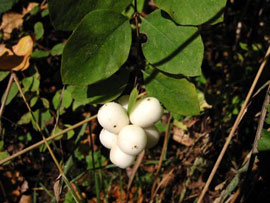
Symphoricarpos albus
Few plants are as aptly named as snowberry. Small bell-like pink flowers give way to scattered clusters of white berries in late summer, which stay on the delicate, arching branches through the fall and much of winter. The small, pale green oval leaves turn a soft yellow in the fall.
Snowberries are at their best in the landscape when combined with other plants. They bring an airy lightness to the understory that contrasts well with the thick evergreen leaves of salal and low Oregon grape, the red stems of red osier dogwoods, and the feathery green foliage of Western hemlock and Western redcedar.
The berries are eaten late in winter by thrushes, towhees, robins, waxwings, and grosbeaks. Anna’s and rufous hummingbirds are attracted to the flowers, as are many species of native bees. Snowberry also provides food for the young of vashti sphinx moths and is generally good cover for wildlife.
Snowberry is tolerant of a wide variety of growing conditions, spreads easily, and makes an excellent addition to any garden.
- Light Requirements: Full Sun, Part Shade, Full Shade
- Water Requirements: Dry, Moist
- Ease of Growing: Easy to grow
- Growth Rate: Fast
- Spreads: Yes
- Wildlife Support: Pollinators, Hummingbirds, Pest-eating Insects, Birds or Mammals
- Fire-resistant: Yes
- Edible: No
- Mature Height: 3-6ft
- Mature Width:2-4ft

